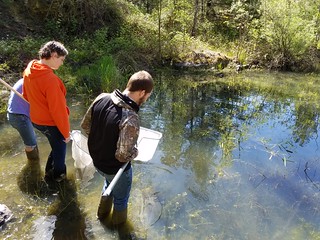I combined a desire to look for extralimital Oregon Slender Salamanders with a need to find a good sampling stream for stream amphibians for my Field Methods class and headed up Rock Creek, a major tributary to the North Umpqua River. I didn't know how far I would get before getting blocked by snow, but to my surprise I made it to about 4000 ft before running into any snow. There was one snow patch across half the road, but it was easily passable. The ridge at roughly 4000 ft, running between Huckleberry Mtn and Silica Mtn, at the headwaters of Mosby Creek (Willamette River drainage) and Pass Creek (tributary to Canton Creek, a trib of the North Umpqua River), had snow on the conifers in the morning when I first got up there. Temperatures in the morning were in the high 30s F and got up to the low 40s before I descended to lower elevations, where things began to warm up.
0913-1035 (43.54077, -122.78413). I started at the junction of BLM 23-1-13, 25-1-31, and Clark Creek Road, . I walked NE over the bank into an old-growth forest. This particular spot was roughly 3600 ft elevation, with a NE slope and moderately steep. It was one of those patches with little ground vegetation, likely because of the steepness, aspect and extensive multilayered canopy. The stand had highly diverse tree, snag, and log sizes and ages. The duff was deep. There were large class 5 logs mostly underground. It was like walking on a stiff bed mattress, a pile of hay, wood chips, or bark mulch--lots of interstitial space below my feet. Occasionally I would even fall through into an old rotten log. It's the kind of place that I've found Oregon Slenders in the Blue River watershed (McKenzie Basin). Given this great habitat, I was surprised to find only one salamander in over an hour of searching. The single Ensatina was "inside" a class 4 log that was half buried in the forest floor. I just happened to grip one grabbable hunk and turned it up, roots from nearby Western Hemlocks attempting to keep it in place, and there was this one Ensatina. I found zero amphibs just under scattered surface objects. I found a couple snails. It was about 40 F in the air and soil/duff. The duff and the inside of many buried rotted logs seemed oddly dry to me. Bird list.
This was the starting point for my trek back, so I began back the way I came.
1100-1154 (43.51805, -122.81308). I saw a few snags in this stand near the road and decided to check out the bark piles and whatever other cover I could find. This site was about 3950 ft elevation, along the ridge mentioned previously. It was at the top of a little knoll with a SSE aspect. It was not steep on the knoll, but was steep below it. It was still in the low 40s F here. This site had less canopy cover and a moderate understory of Rhododendron. The duff was not as deep here, but there were a fair number of small and medium logs, as well as a few snags with bark piles. Here I found a few more animals, 2 Ensatina, 1 Clouded Salamander, and a Vespericola columbianus snail. The Clouded Salamander used its tail to hold on to the bark piece as it descended to take cover after I let it go. Here too, all the salamanders were in locations quite protected, not just under loose surface objects. Bird list.
I had thought that since we had recently had almost a week of rain that there would have been more surface activity by the salamanders, but this did not appear to be the case. I am still pondering why the salamanders seemed in more long-term hiding locations, suggesting they had not been out recently. Was I too late, and their activity peaked a month or two ago? Or was I too early, and they would be out more with warmer rains? I don't know.
On the way down I stopped at a couple spots to look for stream amphibians without luck, and stopped to look at various wildflowers. I found some Douglas Maple at fairly low elevation which was interesting, as well as a few flowers new to me. Finally, I found a fresh pile of "vegetarian" bear scat right next to the road.
There were several nice streams and a few interesting rock outcrops (and a large quarry) worth further exploration.







